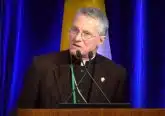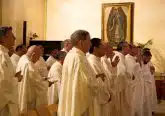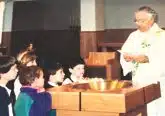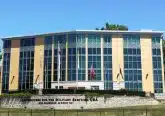Recalling D-Day, 80 Years Ago
Washington D.C., Jun 6, 2014 / 14:04 pm
Men and women across the United States and Europe commemorated the 70th anniversary of D-Day and the events of that fateful day, June 6, 1944, which launched the major turning point in World War II.
Tens of thousands of Allied forces in “Operation Overlord” landed on the beaches of Normandy, France – earning those who took part in the battle there or those on the home front the title of “The Greatest Generation.”
D-Day serves as a powerful reminder of why faith on the battlefield is a spiritual fortress.
More than 156,000 soldiers took part in the Normandy landings. Among them were the chaplains who landed or parachuted with their men, including Father Francis Sampson, who is known as the “Parachute Padre.”
Part of the 501st Parachute Infantry Regiment, he was among the 15,500 soldiers who jumped behind enemy lines.
“Probably no chaplain, Catholic or otherwise, saw more of the horrors of the hedgerow campaign than Francis Sampson,” related Fr. Donald Crosby, S.J., in his book Battlefield Chaplains: Catholic Priests in World War II.
Fr. Sampson quickly tended both spiritually and physically to the wounded and dying before medics showed up, but German SS troops captured him and marched him down the road to execute him, as Fr. Crosby and Lawrence Grayson recounted in a website article called “A Padre in Jump Boots.”
Later, Fr. Sampson would say he was so nervous that he kept repeating the traditional Catholic grace before meals instead of the Act of Contrition. The Germans put him against a wall and raised their guns to shoot him – but then a German officer fired over their heads to stop them.
When Fr. Sampson identified himself as a Catholic priest, the officer saluted, made a slight bow and showed him a Catholic medal pinned inside his uniform. The officer also insisted that Fr. Sampson see pictures of his young child.
“The German officer, who had clearly saved his life, promised him that a German doctor would come by in a day or two and tend to the wounds of the American soldiers,” according to Fr. Crosby.
Through this indirect act, Fr. Sampson saved the American soldiers. He also gave his own blood in a transfusion to a wounded soldier; then he continued working without rest. He was awarded the Distinguished Service Cross for heroism at Normandy.
Fr. Joseph Lacy was awarded the same honor for his role on Omaha Beach that day: his “extraordinary heroism in action” was noticed. Fr. Lacy was a lieutenant with the 5th Ranger Infantry Battalion, which was one of the first groups ashore in the immediate carnage of assault. “Disregarding his own safety,” he “assisted wounded men from the water’s edge,” gave last rites and tended to those in need, all while in the line of enemy fire. He “inspired the men to a similar disregard for the enemy fire.”
That day, the Rangers suffered approximately 50% casualties, but against horrendous odds, they penetrated the enemy’s lines.
“The Chaplain Corps, per capita, was the most highly decorated of all the branches of the Army,” observed Lyle Dorsett, reflecting on the D-Day anniversary. He wrote Serving God and Country: United States Military Chaplains in World War II and is a professor at Beeson Divinity School at Samford University. “It means you’ve got guys on the front, giving and risking their lives so that others can be ministered to.”
Archbishop Broglio
Looking at these events of D-Day and beyond, Archbishop Timothy Broglio of the Archdiocese for the Military Services said, “Certainly, Catholic priests bring the consolation of the sacraments. They stayed with the men on the field and were a great source of encouragement and hope.”
Archbishop Broglio said that on D-Day, Fr. Ignatius Maternowski, a Franciscan, was the only chaplain killed during the invasion. The 32-year-old friar parachuted in with the 82nd Airborne.
Dorsett recalled descriptions of the priest that he heard from those who served with him. “One man said he was a tough, energetic Pole, and he was extremely liked by the men of his regiment,” he told the Register. “He was a man’s man. Chaplains didn’t have to get into the front lines, where there was combat, but these guys refused to stay back. They would go up to the front.”
He “didn’t find it amusing when men were telling filthy jokes, speaking crudely or taking the Lord’s name in vain. More than one time, he would say, ‘Put on boxing gloves’ to anyone who made remarks about the Church or confession.”
Today, there is a memorial in the village of Gueutteville, near where Fr. Maternowski was shot by a Nazi sniper.
“When Fr. Maternowski was fatally shot at Picauville, he was attempting to negotiate with the Nazis to set up a field hospital for both Allied and German wounded soldiers,” Archbishop Broglio said. “He walked into enemy territory, without a gun or helmet, in a brave effort to help the hurt and dying. He died courageously, living out the words of our Savior, putting his life on the line to help others.”
A Veteran Remembers
Bravery and faith marked many of “The Greatest Generation” that day.
Today at 90, Roy Herter of Lantana, Fla., remembers all of the details of that D-Day as if happened yesterday. Back then, he was a 20-year-old with the Big Red One’s First Infantry Division.
“I had a very short career,” he recalled with a chuckle. “I went in the first wave on Omaha Beach.”
“Our job was to silence the big guns firing at the battleships. When we were going in the landing boats and we were halfway in, fellas were saying, ‘This is easy compared to other landings we made.’ Then all hell broke loose. It was the worst and bloodiest battle of any on Omaha Beach.”
Herter continued, without pausing: “We were dumped into deep water, and we were loaded with ammunition and guns. We lost an awful lot of men in the water.
“When we did get in there, we were pinned down, and Rommel (the German commander) had every advantage to push us back into the water. We realized they were cleaning off the beach with every line of soldiers … We really didn’t know whether we were going to get off the beach or not,” he said. There was barbed water, railroad ties and other obstacles. The remaining men had to charge up a long slope, with only a little ledge to hide behind.
“There was a huge gun emplacement with walls 15 feet – not inches – thick. Our grenades only hit screens and bounced back. We realized we still had a couple of bazookas and smaller flamethrowers, and we shot to the front of their guns. It went right into the window next to the gun and knocked out the whole pillbox.”
After they silenced the gun emplacement, they entered the beach’s biggest minefield.
“I was the first man off of the beach into the minefield,” Herter continued. “I stepped on a mine, and it took off my left leg, and shrapnel hit the right [leg]. There was no help at all. It took seven hours before the medics could get off the beach. The only thing I could do was take my belt and tie my left leg, so I didn’t bleed to death.”
“I was sitting in the middle of that beach for seven hours, on this hill, right after we took the gun out, and I had a perfect view of the entire invasion,” he remembered.
Herter said he was put on the second plane evacuating wounded from England to the United States. He refers to his survival and that of his comrades as “blessings of the good God.” In every case, “all you could do was to pray, waiting and wondering for the next step,” he said. “I give God credit for all of this.”
Faith on the Front Lines
As the Normandy campaign continued past D-Day, days later, Fr. Philip Edelen died from artillery fire as he ministered to a fallen soldier, and shortly after, Fr. Dominic Ternan, a Franciscan, died while kneeling next to a wounded soldier during a raging battle. He was awarded the Silver Star.
Dorsett said that his book “is replete with chaplains in foxholes with the men and rescuing guys in battles with fire flying all over and around them.”
Indeed, by war’s end, Marine Commandant Alexander Vandegrift observed that he “frequently noted in the field how chaplains – to a man – sought out front-line action. And I assume that was because, as one put it, at the time: ‘There is where the fighting man needs God most – and that’s where some of them know him for the first time.'”
D-Day, as well as “all war, is a time of men and women asking fundamental questions,” reflected Archbishop Broglio. “They find faith offers themselves some answers.”
He remembered the story of an 18-year-old who was part of the Normandy invasion and was later ordained. His initial experience as a soldier in that invasion led to his vocational decision.
He was referring to the late Msgr. Charles Elmer, who was with the 430th Anti-Aircraft Battalion of the Second Armored division that landed on Omaha Beach and later fought in the Battle of the Bulge. He studied in Rome and later became spiritual director for the North American College at two separate times; in between, he served as a spiritual director and seminary rector in two Texas dioceses.
‘Spiritual Power Wins Wars’
Fr. Sampson was captured during the Battle of the Bulge and remained a POW until the end of the war, saying Mass for his fellow prisoners of war and helping those who were sick. He served as the U.S. Army’s chief of chaplains from 1967 to 1971. The movie Saving Private Ryan was based on one of Fr. Sampson’s missions.
Dorsett related how, when World War II ended, Gen. Vandegrift told Army and Navy chaplains that the long battle from 1941 to 1945, with all the horrid casualties and carnage, could never have been sustained if it hadn’t been for two groups of men – the chaplains and the medics.
And Dorsett also cited the comment of Gen. William Arnold, chief of staff of the Army during World War II. Observed Arnold: “Military power wins battles, but spiritual power wins wars.
This article was originally published by the Catholic News Agency June 6. 2014 on the 70th anniversary of the D-Day invasion.













